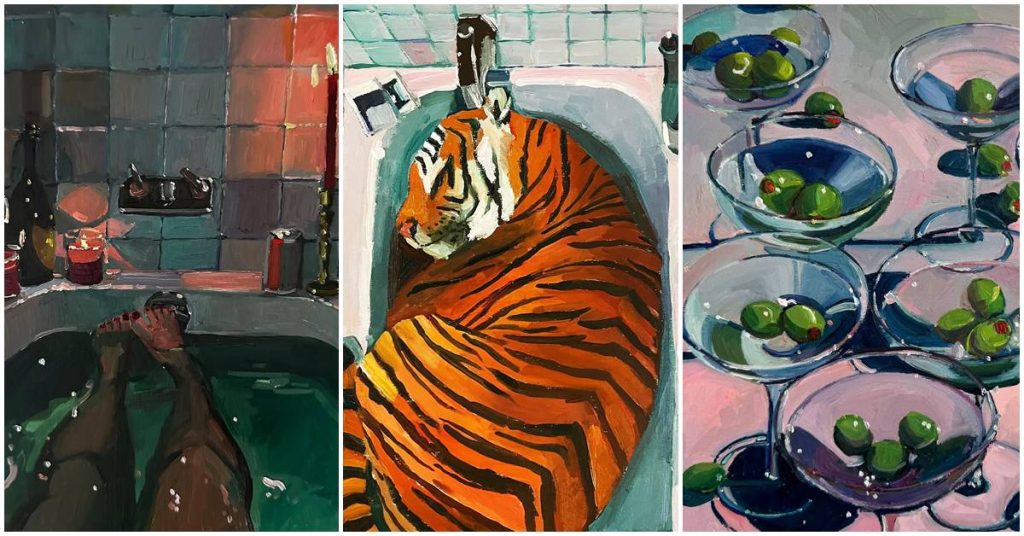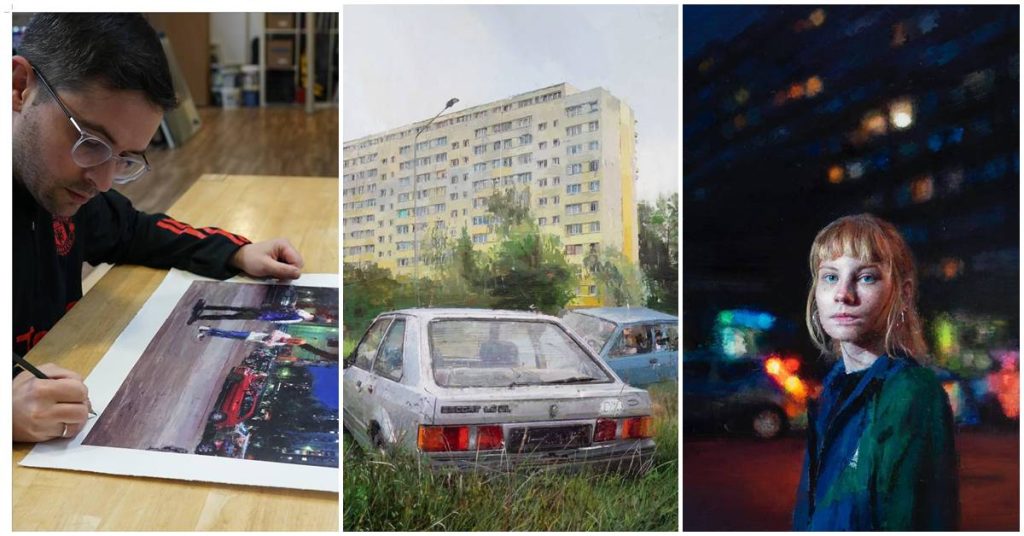Edinburgh, August 6, 2025 — Will Rochfort doesn’t just paint scenes—he builds them. Each of his oil paintings feels like a still from a classic movie. Carefully staged, lit, and composed, his works echo the golden age of Hollywood and 1960s Americana. He calls his process “setting up a film set for one shot only.” And that’s exactly how he treats it.
Rochfort’s fascination with storytelling began early. As a child, he fast-forwarded through Superman: The Movie to relive the part set in the 1960s—old cars, vintage clothes, timeless hairstyles. That aesthetic never left him. “I think I just loved how it looked,” he says. That love for a bygone era led him to develop a painting style that’s cinematic, nostalgic, and grounded in narrative.
Today, Will Rochfort is a full-time oil painter known for constructing complex scenes, often from scratch. He sources props, finds locations, builds models—sometimes full sets—and directs friends and family in carefully choreographed photo shoots. These images become the reference material for his paintings. “The more effort I put into the preparation, the easier and better the painting turns out,” he explains.
His scenes are not accidents. They start as rough sketches—quick scribbles capturing the seed of an idea. He refines these thumbnails, testing compositions and removing anything unnecessary. “I’m usually trying to tell a story,” he says, “so I ask: what’s the simplest way to tell it?” Once he’s confident, he organizes a shoot.
These shoots are elaborate. One painting inspired by an Apollo 11 parade required a 1960s Cadillac, actors dressed as astronauts, police on horseback, and confetti cannons. Another, set during the 1904 stage debut of Peter Pan, involved building parts of a pirate ship and a life-sized cardboard cannon. For Rochfort, cardboard is a go-to material—“if I can’t buy it, rent it, or find it, I’ll build it.”
That hands-on approach stems from childhood. He spent hours building cardboard models and copying scenes from TV. Today, that playfulness still drives him. His studio, filled with vintage cameras, old TVs, and hand-crafted props, is his sanctuary. There’s even a “prop-making department” at the back. It’s where he prepares everything before stepping to the canvas.
He doesn’t work with professional models. “There’s a naturalism when it’s just friends and family,” he says. It’s a choice that adds honesty to his characters. Once he captures the photos, he combines them into a composite image on his iPad. Then comes the painting.
Will Rochfort paints in sections, not layers. He transfers the final sketch onto canvas—sometimes freehand, sometimes using a grid, dots, or a projector (for his sketch, never a photo). “I use charcoal for the sketch because it’s easy to change,” he says. Then he seals it with a light fixative and applies a warm brown or red base coat. This underpainting adds depth and prevents white gaps from showing through.
He paints mostly with five oil colors: Prussian Blue, Yellow Ochre, Cadmium Red, Warm White, and Van Dyke Brown. The latter is his favorite—it helps him build warm shadows and mix versatile blacks. “I used to use loads of colors,” he admits. “But I realized I was always reaching for the same five.”
His brush of choice is the long flat, ranging in size from 0 to 6. “I like the square shape,” he says. “It lets me create chunky strokes or fine lines by turning it sideways.” For details, he uses riggers and half-riggers but never tries to get too precise. “I want to keep the paint loose but deliberate.”
Mistakes are part of the process. “There’s always a stage where the painting looks bad,” he admits. He’s learned to trust that and push through. Sometimes he’ll paint out entire figures if they don’t serve the story. “If it helps the painting, it’s gone.” Earlier in his career, he would walk away from failed paintings. Now, he leans in.
Oil paint gives him that flexibility. “It’s forgiving,” he says. “I can make a mistake, walk away, and fix it later.” That’s why he can never go back to watercolors. He keeps his medium simple too—just linseed oil or a dab of artist medium to make the paint flow like soft butter.
Will Rochfort works at all scales, from small portraits to canvases eight feet wide. He prefers larger formats—they match the boldness of his strokes. He also juggles several paintings at once, especially when deadlines are tight. But one lesson he’s learned is knowing when to stop. “It’s easy to overwork a painting. Less is often more.”
Will Rochfort love of storytelling is the thread through it all. He wants every viewer to feel like they’re walking into a moment already in motion. “I’m always trying to show what happened before, during, and after the scene.” In one painting, three women gather around a suitcase full of money. He titled it The Meeting, gave no backstory, and let viewers fill in the gaps. Theories poured in: sisters plotting revenge, ex-wives celebrating a heist, or strangers caught in a deal. “That’s the power of narrative,” he says.
Other works draw praise for unintended symbolism. One viewer saw Michelangelo’s Creation of Adam in a writer’s pose and complimented him. Rochfort just smiled. “It wasn’t intentional—but I’ll take it.”
His greatest influence is Norman Rockwell. He discovered Rockwell by accident during a seminar at Bournemouth Arts Institute and was instantly hooked. “It was like being struck by lightning,” he says. Rockwell’s ability to tell a full story in one image changed Rochfort’s direction. He switched to oil painting and hasn’t looked back.
Filmmakers like Spielberg and Edgar Wright also inspire him. “They guide your eye exactly where they want it,” he explains. That’s what he aims to do—guide your focus, frame by frame, even in a single painting.
His career took a leap after a small local event, thanks to his mom. She saw an ad for artists in a newspaper and called on his behalf. He joined the New Forest Show, didn’t sell anything—but met someone who remembered him. Two years later, that connection led to a national tour supporting the London 2012 Olympics. Then came gallery representation at Heathrow’s Terminal 5.
“All of that came from a tiny ad I almost ignored,” he says. His motto since then? Make it happen. It keeps him focused, especially when creative work feels overwhelming. “Break it down. Do the first thing. Just make it happen.”
It’s the phrase he’d get tattooed, if he ever did. But for now, his work says it all—scene by scene, brushstroke by brushstroke.
YOU MAY ALSO LIKE TO READ
- Caroline Dewison Builds Tiny Worlds with Big Imagination
- Erika Lee Sears Depicts Her Everyday Life in Optimistic Oil Paintings

Hello art lovers. My name is Deepak Mehla, and I’m from Karnal, India. I enjoy reading stories about people’s struggles and how they overcome them. These motivational stories work like a source of energy for me.
Although Arttellers is completely different from my original vision, I, too, am going through a challenging phase in life. To keep myself busy and to hold on to hope, I share stories of artists with all of you. I believe these stories will give you a new direction, just as they inspire me.
Arttellers exists because I want to share how some people turn the work they love into their livelihood, and how choosing their passion leads them to success. I started Arttellers to keep my own hope alive and to help you discover people whose journeys might inspire you too.



Pingback: Josh Gluckstein: Cardboard Wildlife Artist in London